On the Discovery of a Roman Fortified Site in Gafsa, Southern Tunisia, Based on High-Resolution X-Band Satellite Radar Data
Abstract
:1. Introduction
2. Materials and Methods
2.1. Purpose of the Study
2.2. Study Area
2.3. Data
2.4. Processing Strategy: Rational Basis
2.5. SAR Image Statistics
- (A)
- Generic nonlocal NL denoising of SAR imagery
- (B)
- Nonlocal NL estimation with a weighted maximum likelihood
- (C)
- In the above equation, the weights can be determined as explained in the previous paragraph. The total weight is calculated from all pixels within the search window. To preserve the original resolution, Equation (5) uses only full-resolution input image covariance matrices .
- (D)
- Bias reduction step
3. Results and Discussion
3.1. Assessment of the Detectability of Archeological Structures
3.1.1. CSK Data
3.1.2. TSX SL Images
3.1.3. VHR TSX ST Images
3.2. Optical Image Interpretation Results
3.3. Ground Verification and Discussion
Author Contributions
Funding
Data Availability Statement
Conflicts of Interest
References
- Agapiou, A.; Alexakis, D.D.; Hadjimitsis, D.G. Spectral sensitivity of ALOS, ASTER, IKONOS, LANDSAT and SPOT satellite imagery intended for the detection of archaeological crop marks. Int. J. Digit. Earth 2014, 7, 351–372. [Google Scholar] [CrossRef]
- Altaweel, M. The use of ASTER satellite imagery in archaeological contexts. Archaeol. Prospect. 2005, 12, 151–166. [Google Scholar] [CrossRef]
- Clark, C.; Garrod, S.; Pearson, M.P. Landscape archaeology and remote sensing in southern Madagascar. Int. J. Remote Sens. 1998, 19, 1461–1477. [Google Scholar] [CrossRef]
- Comer, D.C.; Harrower, M.J. Mapping Archaeological Landscapes from Space; Springer: Berlin/Heidelberg, Germany, 2013; Volume 5, pp. 159–171. [Google Scholar]
- Lasaponara, R.; Masini, N. Satellite remote sensing in archaeology: Past, present and future perspectives. J. Archaeol. Sci. 2011, 9, 1995–2002. [Google Scholar] [CrossRef]
- Masini, N.; Lasaponara, R. Sensing the past from space: Approaches to site detection. In Sensing the Past; Springer: Berlin/Heidelberg, Germany, 2017; pp. 23–60. [Google Scholar]
- Parcak, S.H. Satellite Remote Sensing for Archaeology; Routledge: New Delhi, India, 2009. [Google Scholar]
- Beck, A.R. Archaeological site detection: The importance of contrast. In Proceedings of the 2007 Annual Conference of the Remote Sensing and Photogrammetry Society, Newcastle, UK, 11–14 September 2007; Newcastle University: Newcastle, UK, 2007. [Google Scholar]
- Cavalli, R.M.; Pascucci, S.; Pignatti, S. Optimal spectral domain selection for maximizing archaeological signatures: Italy case studies. Sensors 2009, 9, 1754–1767. [Google Scholar] [CrossRef] [Green Version]
- Kalayci, T.; Lasaponara, R.; Wainwright, J.; Masini, N. Multispectral contrast of archaeological features: A quantitative evaluation. Remote Sens. 2019, 11, 913. [Google Scholar] [CrossRef] [Green Version]
- Lasaponara, R.; Masini, N. Detection of archaeological crop marks by using satellite QuickBird multispectral imagery. J. Archaeol. Sci. 2007, 34, 214–221. [Google Scholar] [CrossRef]
- Wilson, D.R. Air Photo Interpretation for Archaeologists; Batsford: Gloucestershire, UK, 1982. [Google Scholar]
- Bachagha, N.; Luo, L.; Wang, X.; Masini, N.; Moussa, T.; Khatteli, H.; Lasaponara, R. Mapping the Roman Water Supply System of the Wadi el Melah Valley in Gafsa, Tunisia, Using Remote Sensing. Sustainability 2020, 12, 567. [Google Scholar] [CrossRef] [Green Version]
- Bachagha, N.; Wang, X.; Luo, L.; Li, L.; Khatteli, H.; Lasaponara, R. Remote sensing and GIS techniques for reconstructing the military fort system on the Roman boundary (Tunisian section) and identifying archaeological sites. Remote Sens. Environ. 2020, 236, 111418. [Google Scholar] [CrossRef]
- De Laet, V.; Paulissen, E.; Waelkens, M. Methods for the extraction of archaeological features from very high-resolution Ikonos-2 remote sensing imagery, Hisar (southwest Turkey). J. Archaeol. Sci. 2007, 34, 830–841. [Google Scholar] [CrossRef]
- Luo, L.; Wang, X.; Guo, H.; Liu, C.; Liu, J.; Li, L.; Du, X.; Qian, G. Automated extraction of the archaeological tops of qanat shafts from VHR imagery in google earth. Remote Sens. 2014, 6, 11956–11976. [Google Scholar] [CrossRef] [Green Version]
- Luo, L.; Wang, X.; Liu, J.; Guo, H.; Lasaponara, R.; Ji, W.; Liu, C. Uncovering the ancient canal-based tuntian agricultural landscape at China’s northwestern frontiers. J. Cult. Herit. 2017, 23, 79–88. [Google Scholar] [CrossRef]
- Luo, L.; Wang, X.; Liu, J.; Guo, H.; Zong, X.; Ji, W.; Cao, H. VHR GeoEye-1 imagery reveals an ancient water landscape at the Longcheng site, northern Chaohu Lake Basin (China). Int. J. Digit. Earth 2017, 10, 139–154. [Google Scholar] [CrossRef]
- Parcak, S. Satellite remote sensing methods for monitoring archaeological tells in the Middle East. J. Field Archaeol. 2007, 32, 65–81. [Google Scholar] [CrossRef]
- Van Ess, M.; Becker, H.; Fassbinder, J.; Kiefl, R.; Lingenfelder, I.; Schreier, G.; Zevenbergen, A. Detection of Looting Activities at Archaeological Sites in Iraq Using Ikonos Imagery; Angewandte Geoinformatik, Beiträge zum 18; Wiechmann-Verlag: Heidelberg, Germany, 2006; pp. 668–678. [Google Scholar]
- El-Baz, F. Prehistoric artifacts near paleo-channels revealed by radar images in the western desert of Egypt. In Remote Sensing in Archaeology from Spacecraft, Aircraft, on Land, and in the Deep Sea; Boston University: Boston, MA, USA, 1998. [Google Scholar]
- McCauley, J.F.; Schaber, G.G.; Breed, C.S.; Grolier, M.J.; Haynes, C.V.; Issawi, B.; Elachi, C.; Blom, R. Subsurface valleys and geoarcheology of the eastern Sahara revealed by shuttle radar. Science 1982, 218, 1004–1020. [Google Scholar] [CrossRef] [PubMed]
- Evans, D.; Pottier, C.; Fletcher, R.; Hensley, S.; Tapley, I.; Milne, A.; Barbetti, M. A comprehensive archaeological map of the world’s largest preindustrial settlement complex at Angkor, Cambodia. Proc. Natl. Acad. Sci. USA 2007, 104, 14277–14282. [Google Scholar] [CrossRef] [PubMed] [Green Version]
- Garrison, T.G.; Chapman, B.; Houston, S.; Román, E.; López, J.L.G. Discovering ancient Maya settlements using airborne radar elevation data. J. Archaeol. Sci. 2011, 38, 1655–1662. [Google Scholar] [CrossRef]
- Cigna, F.; Tapete, D.; Lasaponara, R.; Masini, N. Amplitude change detection with ENVISAT ASAR to image the cultural landscape of the Nasca region, Peru. Archaeol. Prospect. 2013, 20, 117–131. [Google Scholar] [CrossRef]
- Linck, R.; Busche, T.; Buckreuss, S.; Fassbinder, J.W.E.; Seren, S. Possibilities of archaeological prospection by high-resolution X-band satellite radar–a case study from Syria. Archaeol. Prospect. 2013, 20, 97–108. [Google Scholar] [CrossRef]
- Dore, N.; Patruno, J.; Pottier, E.; Crespi, M. New research in polarimetric SAR technique for archaeological purposes using ALOS PALSAR data. Archaeol. Prospect. 2013, 20, 79–87. [Google Scholar] [CrossRef]
- Jiang, A.; Chen, F.; Masini, N.; Capozzoli, L.; Romano, G.; Sileo, M.; Yang, R.; Tang, P.; Chen, P.; Lasaponara, R.; et al. Archeological crop marks identified from Cosmo-SkyMed time series: The case of Han-Wei capital city, Luoyang, China. Int. J. Digit. Earth 2017, 10, 846–860. [Google Scholar] [CrossRef]
- Patruno, J.; Dore, N.; Crespi, M.; Pottier, E. Polarimetric Multifrequency and Multi-incidence SAR Sensors Analysis for Archaeological Purposes. Archaeol. Prospect. 2013, 20, 89–96. [Google Scholar] [CrossRef]
- Morrison, K. Mapping subsurface archaeology with SAR. Archaeol. Prospect. 2013, 20, 149–160. [Google Scholar] [CrossRef]
- Collins, A. Beneath the Pyramids: Egypt’s Greatest Secret Uncovered; A.R.E. Press (Association of Research & Enlig): Virginia Beach, VA, USA, 2009. [Google Scholar]
- Di Iorio, A.; Straccia, N.; Carlucci, R. Advancement in automatic monitoring and detection of archaeological sites using a hybrid process of remote sensing, GIS techniques and a shape detection algorithm. In Proceedings of the 30th EARSeL Symposium, Paris, France, 2–24 May 2010. [Google Scholar]
- Tapete, D.; Cigna, F. Rapid mapping and deformation analysis over cultural heritage and rural sites based on Persistent Scatterer Interferometry. Int. J. Geophys. 2012, 2012, 618609. [Google Scholar]
- Comer, D.C.; Blom, R.G. Detection and identification of archaeological sites and features using Synthetic Aperture Radar (SAR) data collected from airborne platforms. In Remote Sensing in Archaeology; Springer: Berlin/Heidelberg, Germany, 2006; pp. 103–136. [Google Scholar]
- Stewart, C.; di Iorio, A.; Schiavon, G. Analysis of the utility of Cosmo Skymed stripmap to detect buried archaeological features in the region of Rome. Experimental component of WHERE project. In Proceedings of the Towards Horizon 2020: Earth Observation and Social Perspectives, Matera, Italy, 3–6 June 2013; pp. 203–212. [Google Scholar]
- Chen, F.; Lasaponara, R.; Masini, N. An overview of satellite synthetic aperture radar remote sensing in archaeology: From site detection to monitoring. J. Cult. Herit. 2017, 23, 5–11. [Google Scholar] [CrossRef]
- Gade, M.; Kohlus, J. SAR imaging of archeological sites on dry-fallen intertidal flats in the German Wadden Sea. In Proceedings of the 2015 IEEE International Geoscience and Remote Sensing Symposium (IGARSS), Brussels, Belgium, 26–31 July 2015; IEEE: Piscataway, NJ, USA, 2015. [Google Scholar]
- Caltagirone, F.; Coletta, A.; de Luca, G. COSMO-SkyMed Mission and Products Description; Italian Space Agency Doc.: Rome, Italy, 2014. [Google Scholar]
- Chen, F.; Masini, N.; Yang, R.; Milillo, P.; Feng, D.; Lasaponara, R. A space view of radar archaeological marks: First applications of COSMO-SkyMed X-band data. Remote Sens. 2014, 71, 24–50. [Google Scholar] [CrossRef] [Green Version]
- Balss, U.; Gisinger, C.; Cong, X.Y.; Brcic, R.; Steigenberger, P.; Eineder, M.; Pail, R.; Hugentobler, U. High resolution geodetic earth observation with TerraSAR-X: Correction schemes and validation. In Proceedings of the 2013 IEEE International Geoscience and Remote Sensing Symposium-IGARSS, Melbourne, VIC, Australia, 21–26 July 2013; IEEE: Piscataway, NJ, USA, 2013. [Google Scholar]
- Balz, T.; Liao, M.; Caspari, G.; Fu, B.; Rosenbauer, R.; Erasmi, S. Analyzing TerraSAR-X staring spotlight mode data for archaeological prospections in the Altai Mountains. In Proceedings of the 2015 IEEE 5th Asia-Pacific Conference on Synthetic Aperture Radar (APSAR), Singapore, 1–4 September 2015; IEEE: Piscataway, NJ, USA, 2015. [Google Scholar]
- Khanoussi, M. Note sur la date de promotion de Capsa (Gafsa, en Tunisie) au rang de colonie romaine (Note d’information). In Comptes Rendus des Séances de l’Académie des Inscriptions et Belles-Lettres; Nabu Press: Charleston, SC, USA, 2010; Volume 154, pp. 1009–1020. [Google Scholar]
- Brahmi, M. Thiges et le castellum Thigensium. In Géographie Historique du Maghreb Antique et Médiéval: États des Lieux et Perspectives de Recherches, Actes du 1er Colloque International du Laboratoire de Recherche Occupation du sol, Peuplement et Modes de Vie Dans le Maghreb Antique et Médiéval; Université de Sousse, Faculté des Lettres et des Sciences Humaine: Sousse, Tunisia, 2015. [Google Scholar]
- Ch, T. Géographie Comparée de la Province Romaine d’Afrique, t. II; Exploration Scientifique de la Tunisie: Paris, France, 1888. [Google Scholar]
- Euzennat, M. Quatre années de recherches sur la frontière romaine en Tunisie méridionale. C. R. Séances Acad. Inscr. Belles-Lett. 1972, 116, 7–27. [Google Scholar]
- Toussaint, P. Résumé des Connaissances Archéologiques Exécutées par les Officiers des Brigades Topographiques d’Algérie et de Tunisie; Bulletin Archéologique du Comité: Paris, France, 1904; pp. 137–138. [Google Scholar]
- Toutain, J. Note sur quelques voies romaines de l’Afrique proconsulaire. In Mélanges d’Archéologie et d’Histoire; École Française de Rome: Rome, Italy, 1895; Volume XV. [Google Scholar]
- Chen, F.; Guo, H.; Tapete, D.; Masini, N.; Cigna, F.; Lasaponara, R.; Piro, S.; Lin, H.; Ma, P. Interdisciplinary approaches based on imaging radar enable cutting-edge cultural heritage applications. Natl. Sci. Rev. 2021, 8, nwab123. [Google Scholar] [CrossRef]
- Elfadaly, A.; Abate, N.; Masini, N.; Lasaponara, R. SAR sentinel 1 imaging and detection of palaeo-landscape features in the mediterranean area. Remote Sens. 2020, 12, 2611. [Google Scholar] [CrossRef]
- Goodman, N.R. Statistical analysis based on a certain multivariate complex Gaussian distribution (an introduction). Ann. Math. Stat. 1963, 34, 152–177. [Google Scholar] [CrossRef]
- Deledalle, C.A.; Denis, L.; Tupin, F.; Reigber, A.; Jäger, M. Additional Illustrations of NL-SAR Method for Resolution-Preserving (Pol) (In) SAR Denoising. 2014. Available online: https://hal.archives-ouvertes.fr/hal-00955194v4 (accessed on 24 April 2022).
- Buades, A.; Coll, B.; Morel, J.M. A non-local algorithm for image denoising. In Proceedings of the IEEE Computer Society Conference on Computer Vision and Pattern Recognition IEEE Computer Society, San Diego, CA, USA, 20–25 June 2005. [Google Scholar]
- Deledalle, C.-A.; Denis, L.; Tupin, F. Iterative weighted maximum likelihood denoising with probabilistic patch-based weights. IEEE Trans. Image Process. 2009, 18, 2661–2672. [Google Scholar] [CrossRef] [Green Version]
- Polzehl, J.; Spokoiny, V. Propagation-separation approach for local likelihood estimation. Probab. Theory Relat. Fields 2006, 135, 335–362. [Google Scholar] [CrossRef] [Green Version]
- Lee, J. Refined filtering of image noise using local statistics: Computer Graphics & Image Processing, 15, 380–389. cgi CGIPBG 0146-664X Computer Graphics Image Processing Crossref Google Scholar 1981b. Speckle analysis and smoothing of synthetic aperture radar images. Comput. Graph. Image Process. 1981, 17, 24–32. [Google Scholar]
- Eineder, M.; Minet, C.; Steigenberger, P.; Cong, X.; Fritz, T. Imaging geodesy—Toward centimeter-level ranging accuracy with TerraSAR-X. IEEE Trans. Geosci. Remote Sens. 2010, 49, 661–671. [Google Scholar] [CrossRef]
- Schubert, A.; Jehle, M.; Small, D.; Meier, E. Influence of atmospheric path delay on the absolute geolocation accuracy of TerraSAR-X high-resolution products. IEEE Trans. Geosci. Remote Sens. 2009, 48, 751–758. [Google Scholar] [CrossRef]
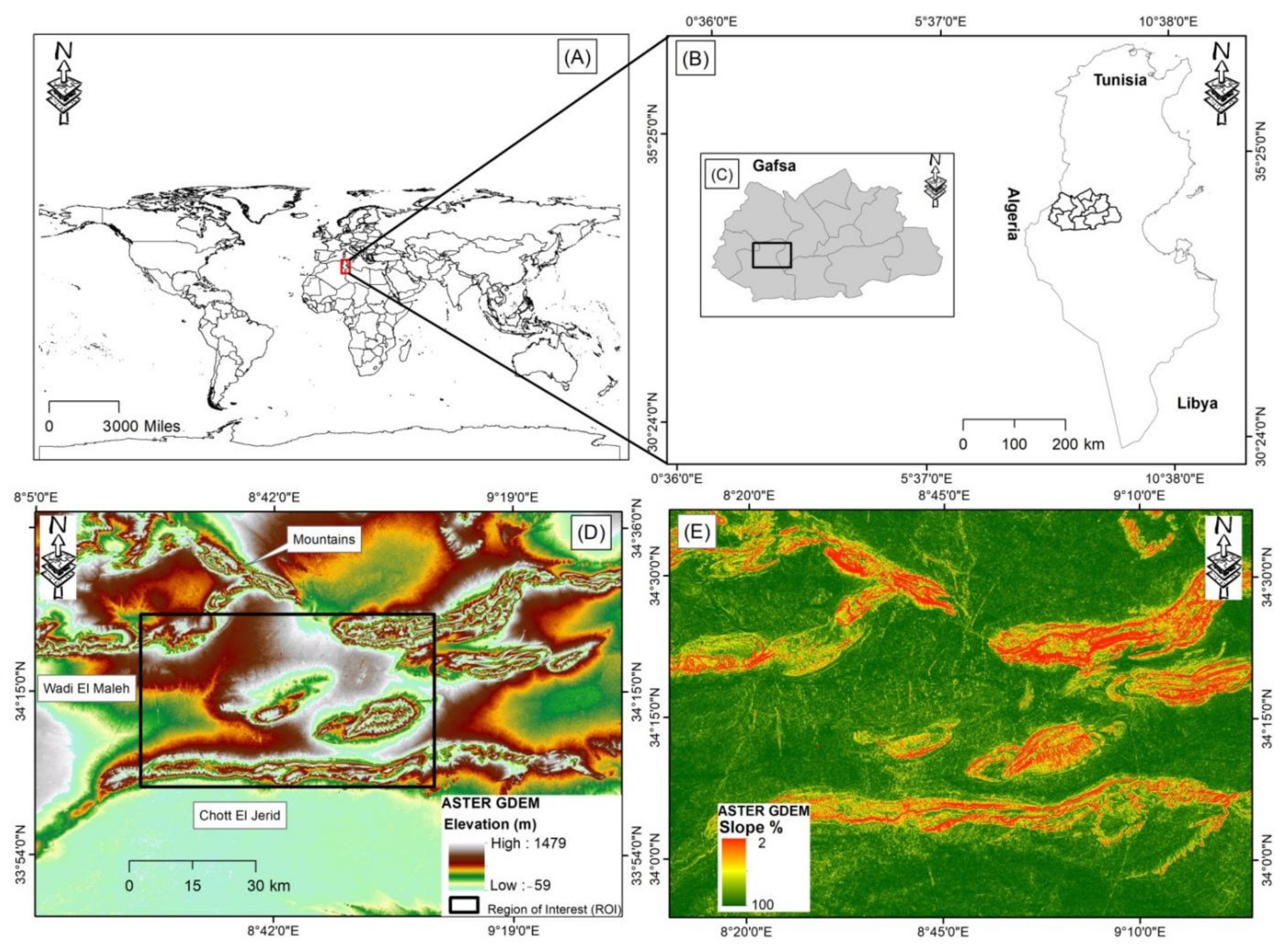
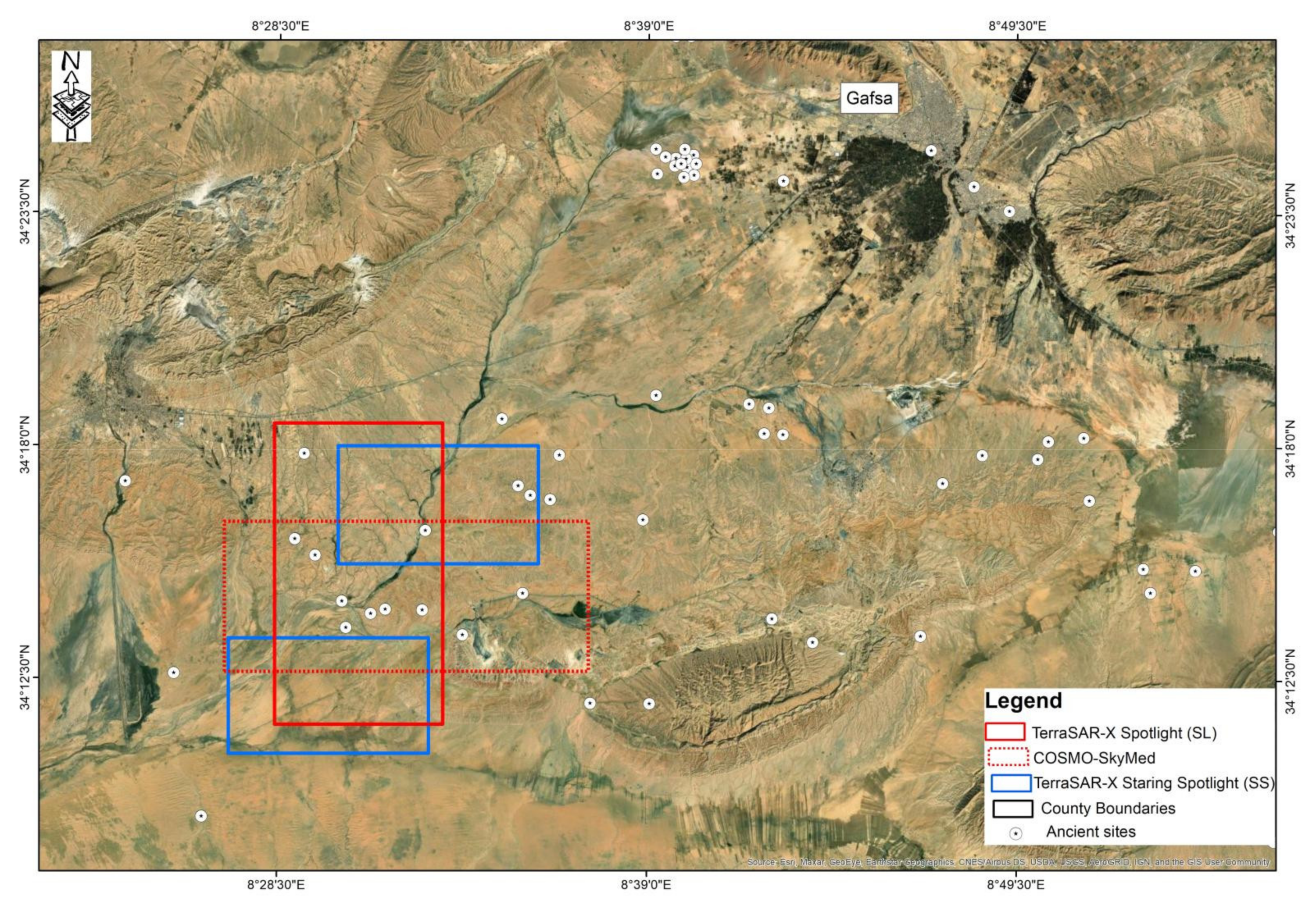
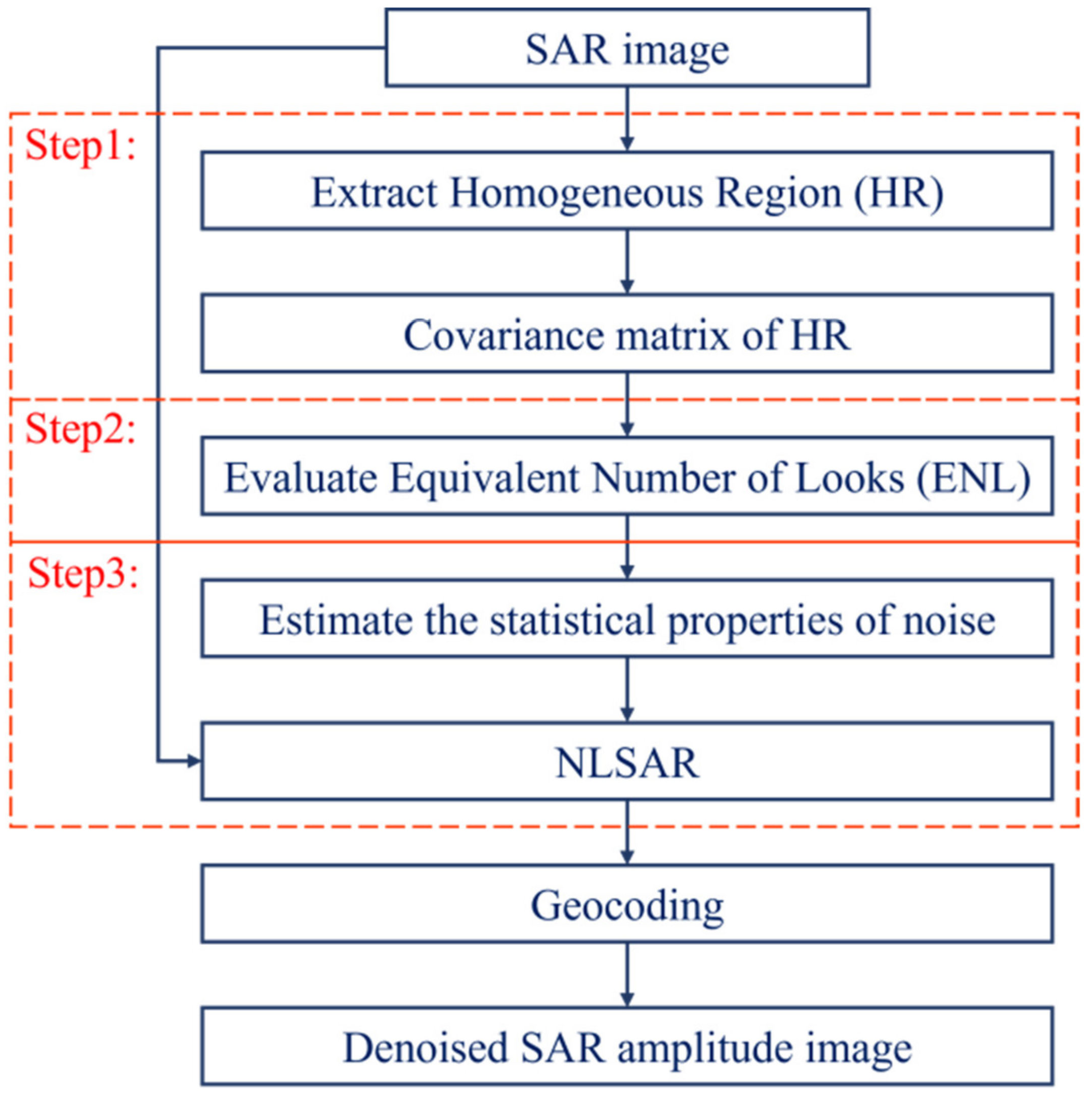
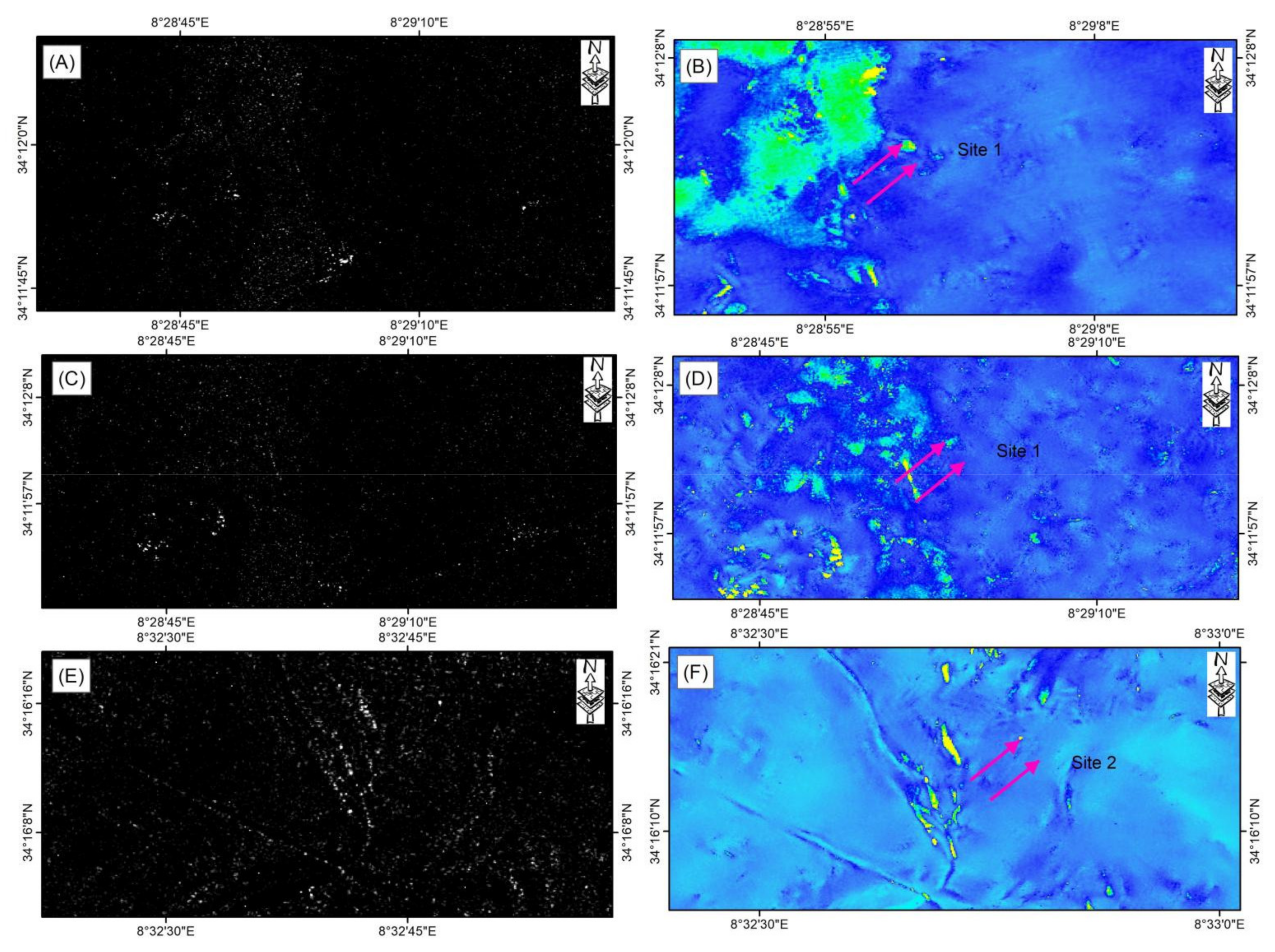
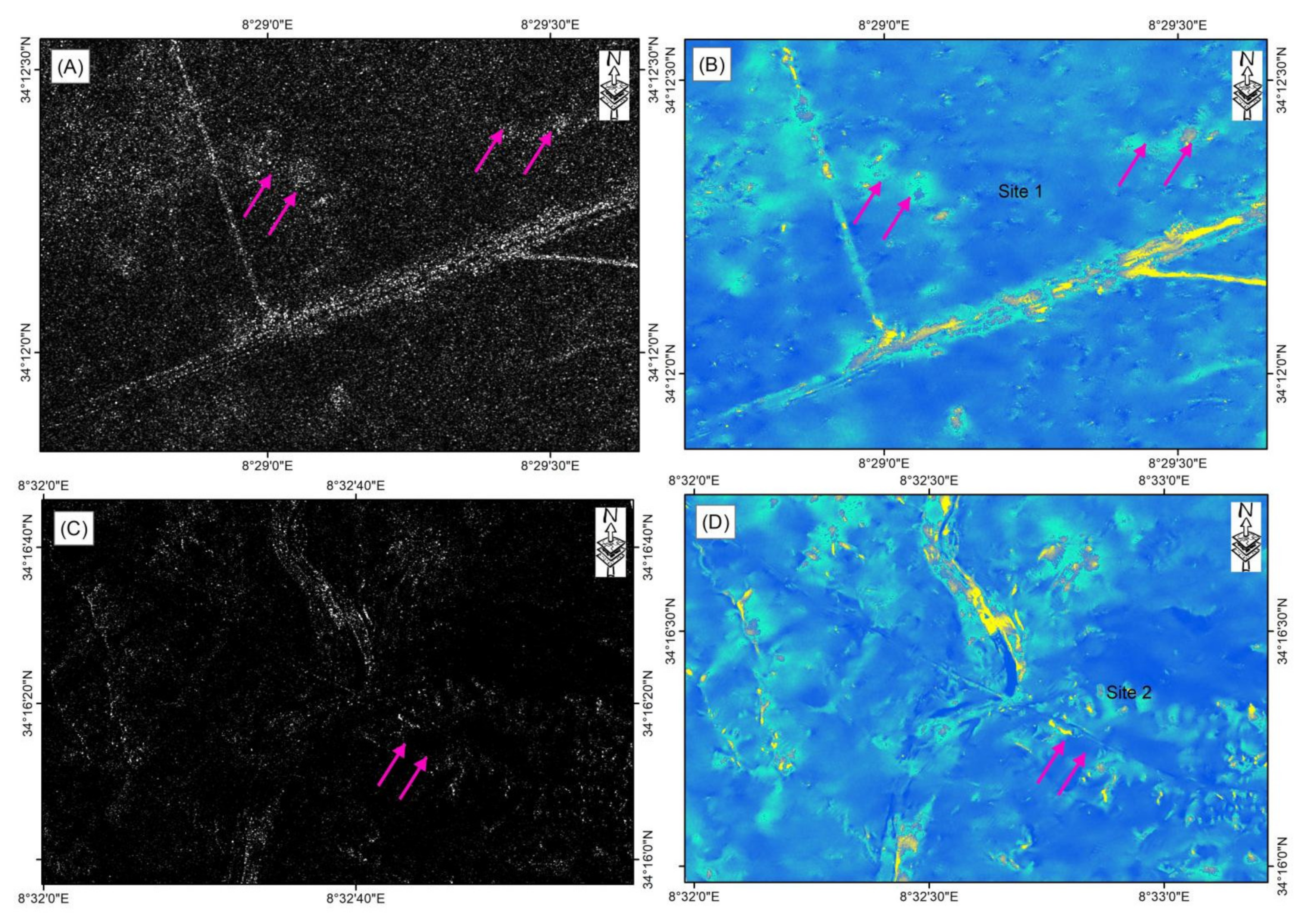
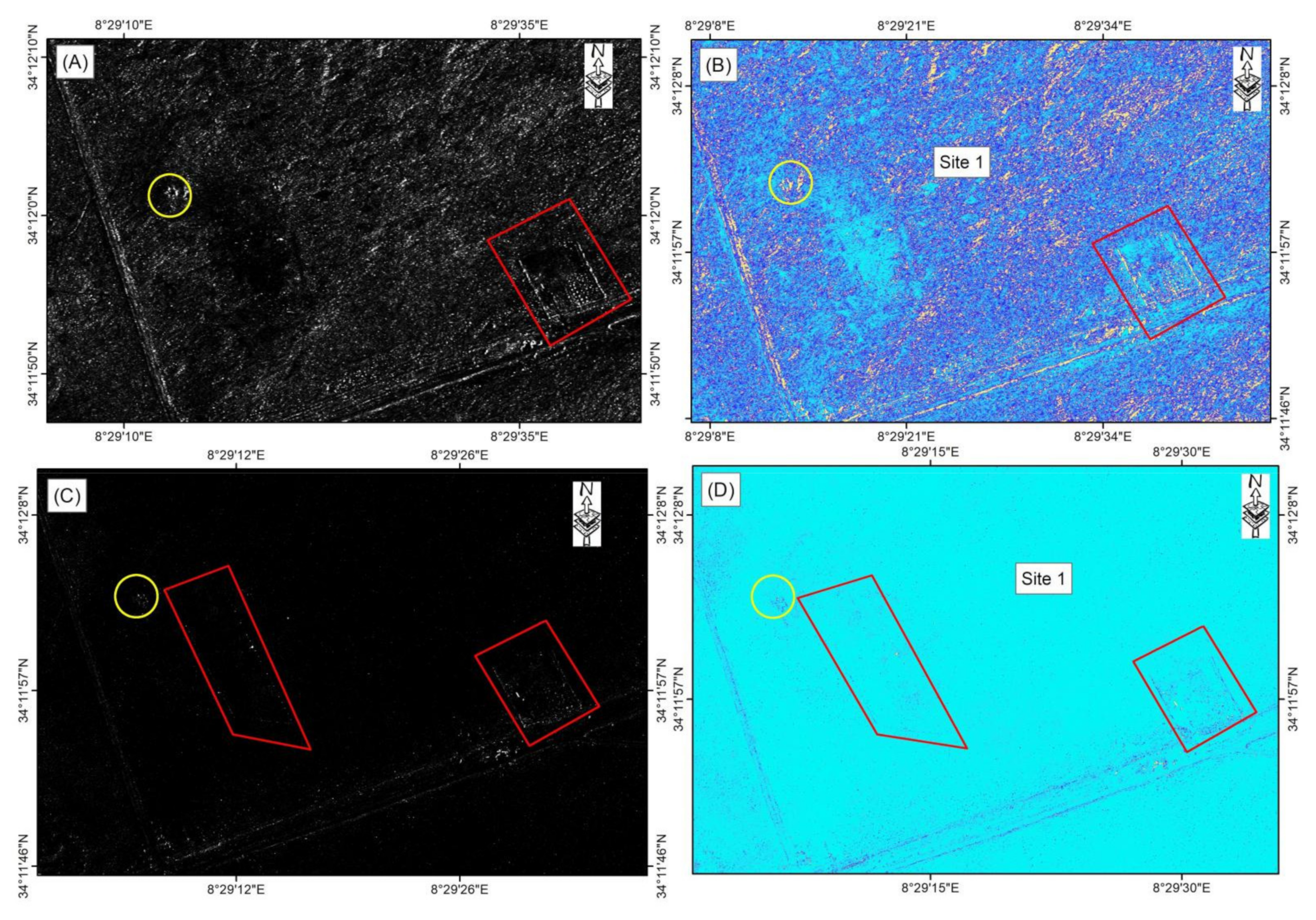
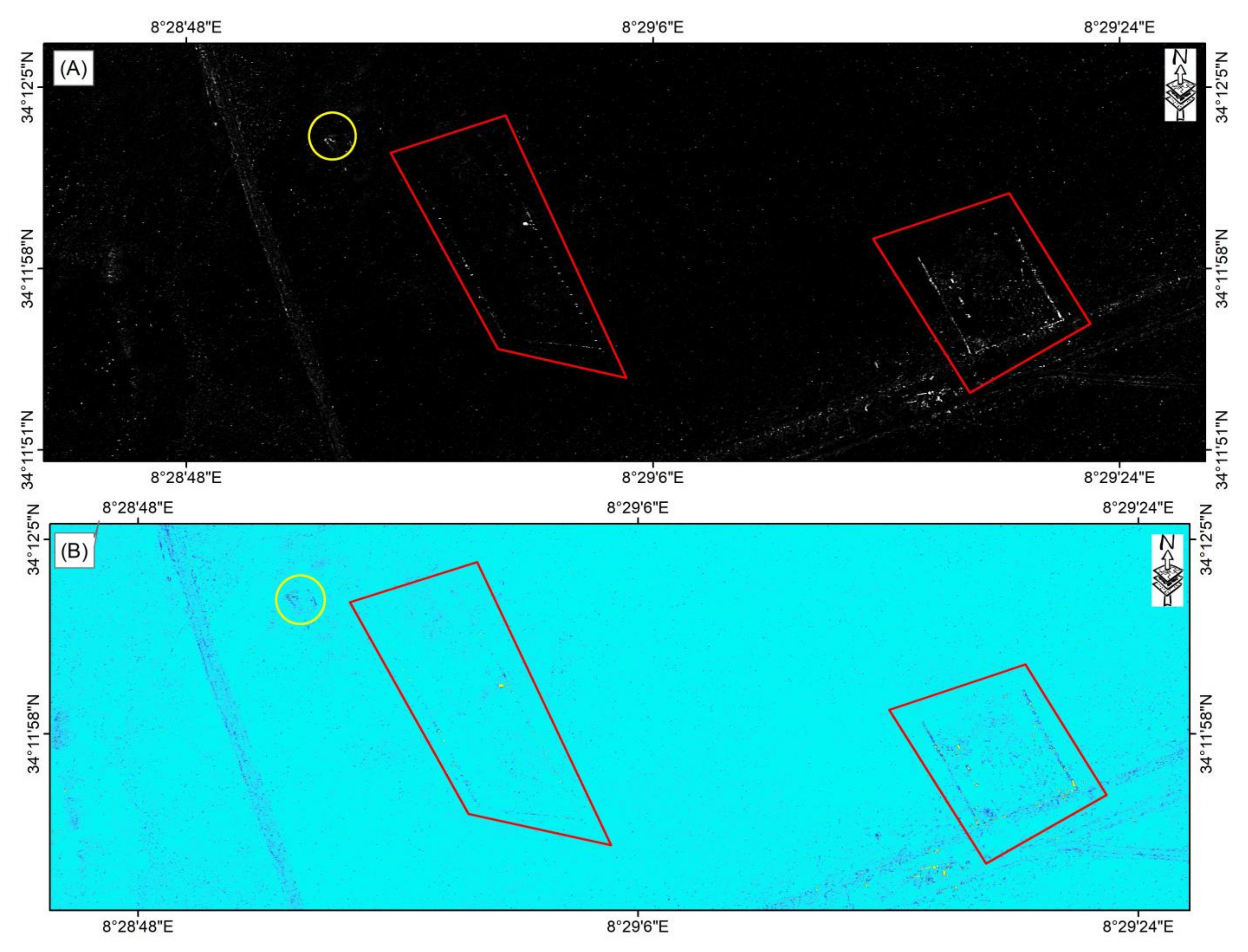
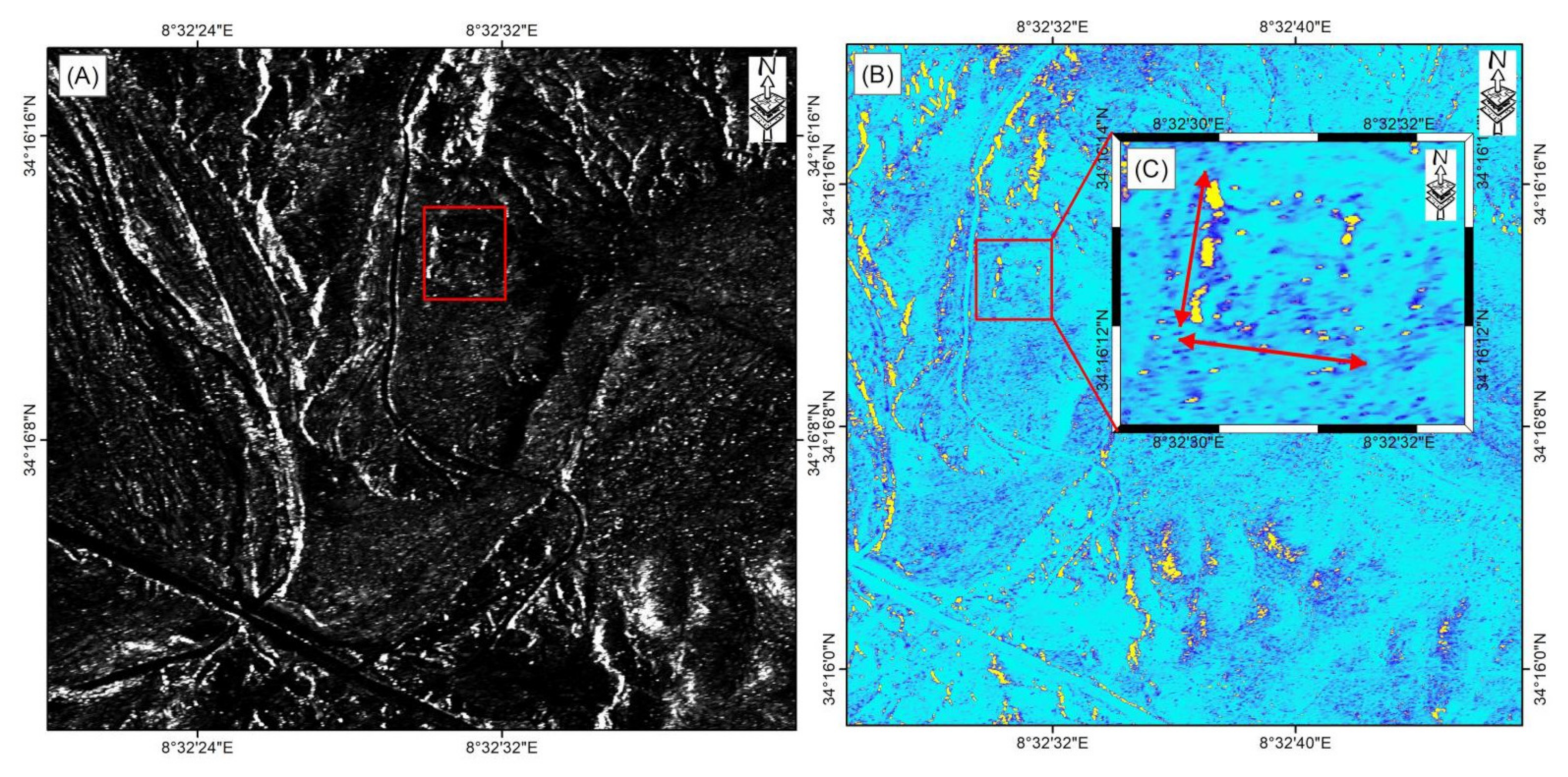

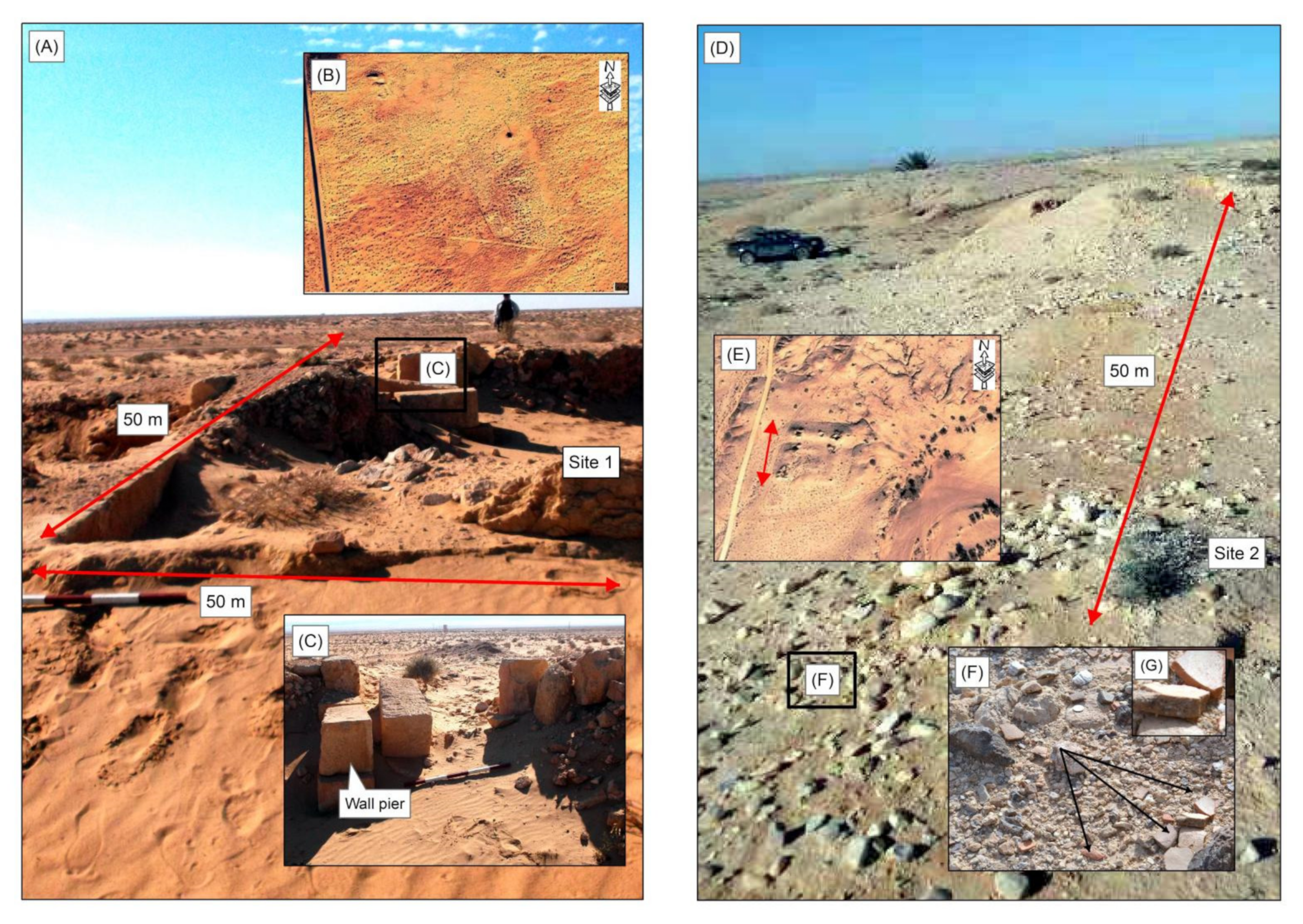
| Site | Sensor | Radar Band | Instrument Mode | Incidence Angle | Range Resolution (Res.) (M) | Azimuth Res. (M) |
|---|---|---|---|---|---|---|
| Site 1 | TSX | X-band | SL | 38.5895 | 1.3641 (slant range) | 1.8273 |
| TSX | X-band | ST | 20.6381 | 0.4000 (ground range) | 0.4000 | |
| TSX | X-band | ST | 38.8575 | 0.2200 (ground range) | 0.2200 | |
| TSX | X-band | ST | 38.6253 | 0.2200 (ground range) | 0.2200 | |
| CSK | X-band | SL | 24.0098 | 0.9749 (slant range) | 1.8005 | |
| CSK | X-band | SL | 26.6448 | 0.9295 (slant range) | 2.2041 | |
| Site 2 | TSX | X-band | SL | 38.5895 | 1.3641 (slant range) | 1.8273 |
| TSX | X-band | ST | 21.0969 | 0.3800 (ground range) | 0.3800 | |
| CSK | X-band | SL | 26.6448 | 0.9295 (slant range) | 2.2041 |
| Sensors | Ziyuan-3 (ZY-3) | |
|---|---|---|
| Wavelength (µm) | PAN | 0.50–0.80 |
| MS | 0.45–0.52 Blue | |
| 0.52–0.59 Green | ||
| 0.63–0.69 Red | ||
| 0.77–0.89 NIR | ||
| Spatial resolution (m) | PAN | 2.1 |
| MS | 5.8 |
Publisher’s Note: MDPI stays neutral with regard to jurisdictional claims in published maps and institutional affiliations. |
© 2022 by the authors. Licensee MDPI, Basel, Switzerland. This article is an open access article distributed under the terms and conditions of the Creative Commons Attribution (CC BY) license (https://creativecommons.org/licenses/by/4.0/).
Share and Cite
Bachagha, N.; Xu, W.; Luo, X.; Masini, N.; Brahmi, M.; Wang, X.; Souei, F.; Lasaponora, R. On the Discovery of a Roman Fortified Site in Gafsa, Southern Tunisia, Based on High-Resolution X-Band Satellite Radar Data. Remote Sens. 2022, 14, 2128. https://doi.org/10.3390/rs14092128
Bachagha N, Xu W, Luo X, Masini N, Brahmi M, Wang X, Souei F, Lasaponora R. On the Discovery of a Roman Fortified Site in Gafsa, Southern Tunisia, Based on High-Resolution X-Band Satellite Radar Data. Remote Sensing. 2022; 14(9):2128. https://doi.org/10.3390/rs14092128
Chicago/Turabian StyleBachagha, Nabil, Wenbin Xu, Xingjun Luo, Nicola Masini, Mondher Brahmi, Xinyuan Wang, Fatma Souei, and Rosa Lasaponora. 2022. "On the Discovery of a Roman Fortified Site in Gafsa, Southern Tunisia, Based on High-Resolution X-Band Satellite Radar Data" Remote Sensing 14, no. 9: 2128. https://doi.org/10.3390/rs14092128
APA StyleBachagha, N., Xu, W., Luo, X., Masini, N., Brahmi, M., Wang, X., Souei, F., & Lasaponora, R. (2022). On the Discovery of a Roman Fortified Site in Gafsa, Southern Tunisia, Based on High-Resolution X-Band Satellite Radar Data. Remote Sensing, 14(9), 2128. https://doi.org/10.3390/rs14092128








